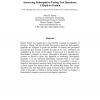Free Online Productivity Tools
i2Speak
i2Symbol
i2OCR
iTex2Img
iWeb2Print
iWeb2Shot
i2Type
iPdf2Split
iPdf2Merge
i2Bopomofo
i2Arabic
i2Style
i2Image
i2PDF
iLatex2Rtf
Sci2ools
CORR
2002
Springer
2002
Springer
Answering Subcognitive Turing Test Questions: A Reply to French
Robert French has argued that a disembodied computer is incapable of passing a Turing Test that includes subcognitive questions. Subcognitive questions are designed to probe the network of cultural and perceptual associations that humans naturally develop as we live, embodied and embedded in the world. In this paper, I show how it is possible for a disembodied computer to answer subcognitive questions appropriately, contrary to French's claim. My approach to answering subcognitive questions is to use statistical information extracted from a very large collection of text. In particular, I show how it is possible to answer a sample of subcognitive questions taken from French, by issuing queries to a search engine that indexes about 350 million Web pages. This simple algorithm may shed light on the nature of human (sub-) cognition, but the scope of this paper is limited to demonstrating that French is mistaken: a disembodied computer can answer subcognitive questions.
| Added | 18 Dec 2010 |
| Updated | 18 Dec 2010 |
| Type | Journal |
| Year | 2002 |
| Where | CORR |
| Authors | Peter D. Turney |
Comments (0)

